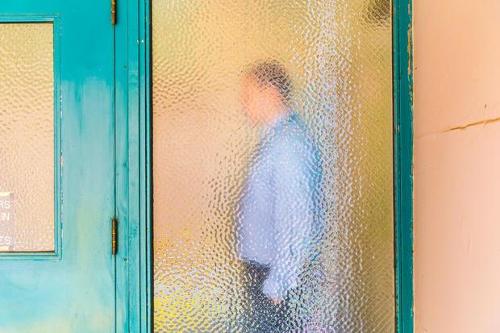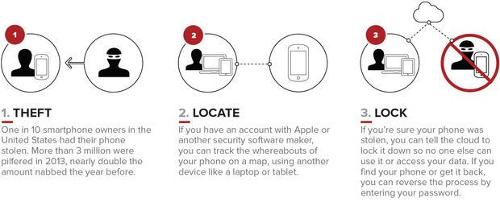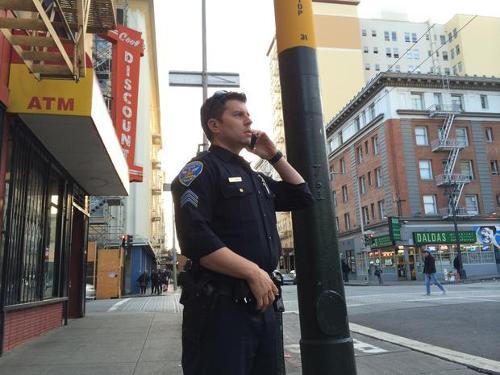This little article is about stealing #smartphones. It's an
interesting read.
https://www.yahoo.com/tech/confessions-of-a-smartphone-thief-101677365014.html Greg stole five iPhones before he got caught. He says kids might think twice about stealing phones if they knew they couldn’t be unlocked.(James Martin/CNET)
Greg stole five iPhones before he got caught. He says kids might think twice about stealing phones if they knew they couldn’t be unlocked.(James Martin/CNET)
Every smartphone Greg stole was an iPhone. The 19-year-old snatched five in all, once picking up two in a day.
His last grab, in a sleepy San Francisco neighborhood near the city’s coastline in May 2013, was a bust — in more ways than one. He thought he was going after an iPhone 5, Apple’s newest model at the time. He ended up with the iPhone 4, which fetches half the amount on the black market. The pull landed him a disappointing $100 and a trip to juvenile hall — his first time being caught for smartphone theft.
At the detention center, the staff wasn’t surprised by his crime. “When you get to booking, that’s one of the first things they ask you: ‘A cell phone, right?’ ” says Greg (not his real name).
Smartphones are a top choice for today’s street criminals, especially teenagers. In the 12 months ending in June 2013, nearly two-thirds of robberies by minors in San Francisco involved cellphones, according to the city’s public defender.
Government officials have called the trend an epidemic. One in 10 smartphone owners in the United States have had their phone stolen. More than 3 million were pilfered in 2013, nearly double the number nabbed the year before.
In tech-obsessed San Francisco, more than 65 percent of robberies in early 2014 involved mobile devices. Across the bay in Oakland, the number spiked to over 75 percent, according to California State Sen. Mark Leno, who proposed a bill requiring that smartphones include “kill switches.” In late August, Gov. Jerry Brown signed the bill, which will mandate that any smartphone sold in the state after July 2015 include the technology. The theft-deterrent software is designed to make stealing phones pointless by letting owners lock a lost device so no one can use it.
A last grab
Greg is tall but not imposing, with a sturdy build and a gentle handshake. That handshake is a surprise, given his preferred technique: quickly yanking the phone from a victim’s grasp instead of relying on the sleight of hand of pickpocketing.
Greg is tall but not imposing, with a sturdy build and a gentle handshake. That handshake is a surprise, given his preferred technique: quickly yanking the phone from a victim’s grasp instead of relying on the sleight of hand of pickpocketing.
When I first met Greg, he was dressed in a striped collared shirt, gray skinny tie, and black slacks. After our interview, he rushed off to his internship at a Bay Area company.
But in May 2013, Greg was in more desperate circumstances. He spotted his last mark standing on the sidewalk not far from where he lived. The woman was Asian, petite, and about 20 years old. She was standing in front of her van, talking on her phone.
“Yes, there are stereotypes,” Greg admits, sheepishly, after I ask him if he picked a certain “type” to rob. “You’re not going to want to try to take somebody’s phone if you think there might actually be a struggle.”
Greg had doubts before making the grab that day. He hadn’t been in trouble for 18 months, although he had two prior stints in juvie for noncriminal charges. There were a few violations here and there — remnants from falling in with the wrong crowd while growing up in a housing project. But he thought about his 9-month-old daughter. He didn’t have a job, and his mom had been diagnosed with cancer two months before. The family was squeezing every penny from her disability check.

Greg parked his car around the corner. His girlfriend — the mother of his child — was in the passenger seat. He approached his target, plucked the phone from her hand, and ran. Then he drove to a plaza downtown that’s well known as the place to buy and sell stolen phones. He sold the iPhone, but as he drove away, the cops pulled him over.
Turns out the police were tracking the phone from the owner’s iPad using Apple’s Find My iPhone software, which pinpoints the device’s whereabouts on a map. The cops found a hundred dollar bill in Greg’s cup holder. “I could have beat the case, because I didn’t get caught with the phone,” he says. Only one problem: His girlfriend was in the car, and if they fought the charge, no one would be able to look after their daughter. “I didn’t want to have to go to trial and have both of us in there.”
Greg’s mother died during his two weeks in juvenile hall, ultimately leading him to rethink his life and resorting to theft to pay the bills.
Food to a pigeon
“Victim,” says SFPD patrolman Sgt. Shaughn Ryan. He’s pointing to a woman walking by the corner of Leavenworth and O’Farrell streets in the belly of the Tenderloin, one of San Francisco’s roughest neighborhoods. She’s toting a big beige purse and staring at her iPhone.
“Victim,” says SFPD patrolman Sgt. Shaughn Ryan. He’s pointing to a woman walking by the corner of Leavenworth and O’Farrell streets in the belly of the Tenderloin, one of San Francisco’s roughest neighborhoods. She’s toting a big beige purse and staring at her iPhone.
She’s not actually a victim but could easily become one as she walks passed us. Eyes fixed on her screen, she’s numb to the buzz of the street around her. Ryan stops the squad car, a black and white Chevy SUV, and from his open window advises her she should pay more attention to where she’s going. The woman — who says she’s on her way to a popular bar at the edge of the neighborhood — shyly abides and disappears down the street. (A few minutes later he cruises by the bar to see if she’s made it.)
It’s Friday night of Memorial Day weekend. I’m on a police ride-along with Ryan and his partner, Sgt. Kevin Horan, to try to understand the crime wave at a granular level: by seeing what’s going on in the streets. Smartphone theft has become so rampant that the cops point out three other potential victims during the course of the night. They know I’m here to write about smartphone theft, but I get the idea they’d single out the easy targets to anyone — trying to make sure they don’t become statistics.
As our squad car weaves through the squashed-together neighborhoods of downtown San Francisco, we pass a halfway house, a tony art gallery, a flagship Macy’s store, and a man with congealed blood streaked down the side of his face. Patrolling through the area is like tunneling through Super Mario Bros. pipes. And that’s what makes this particular place such a hub of gadget theft: It’s the nexus of poverty, affluence, obliviousness, and opportunity.

The cops tell me every street in the Tenderloin is known for a different drug. Crack on one corner, pills on another. Market and 7th Street is for smartphones. We roll by the corner, where Greg was caught last May. It is a vast, open square in the shadow of San Francisco’s City Hall. A group of men in their twenties and thirties lean against the window of a Carl’s Jr. The cops suspect they are here to do business.
“This is ground zero for smartphone fencing,” says Horan, referring to buying and reselling stolen goods.
When a kid with a smartphone flashes his wares, the men come flocking. “It’s like throwing food out to a pigeon,” says Marwan Eadeh, owner of the World of Stereo store, a few blocks away. Investigators aren’t sure where most stolen phones end up. Some make their way to local flea markets. Others journey to destinations as far-flung as Lima and Hong Kong.
Black-market buyers are looking for phones that are unlocked, or unprotected by the security features that make them harder to restore to factory settings. Newer iPhones — anything running Apple’s iOS 7 software or later — are more likely to have the feature enabled. That makes slightly older phones more attractive on the black market, Greg says.
A phone’s wireless provider also affects street prices. AT&T and T-Mobile phones rake in the highest take, Greg says, because they’re configured for global communications and therefore are easier to resell overseas.
The Holy Grail is the newest iPhone, unlocked and running on AT&T or T-Mobile networks. The 5s, the latest model at the time I spoke to Greg, might fetch $300 to $400, he says. It’s $650 new. The same model on another network might yield $100 or $150 less. An unlocked Samsung Galaxy S5, which could have cost $660 new, might fetch $100 to $200 on the street, police say.
While each model has its going rate, thieves often just take what they can get. “There’s no such thing as getting ripped off in this kind of game,” says Greg, since you’re selling something that’s not yours anyway.
Legislating protection
San Francisco police say Apple has worked with them on sting operations dating back to 2009. But such stings drain resources — and don’t get to the heart of the problem.
San Francisco police say Apple has worked with them on sting operations dating back to 2009. But such stings drain resources — and don’t get to the heart of the problem.
Lawmakers are hoping that kill-switch software will do the trick. Samsung and Apple, the world’s two largest smartphone makers, already include software that lets users remotely lock their phones and delete data. Google’s latest version of its Android mobile operating system also has a kill switch. Legislation like California’s bill will require that anti-theft software be automatically enabled instead of requiring users to turn it on. Apple’s iOS 8, released in September, already enables the software by default.
“This is not an enforcement problem,” says SFPD Capt. Jason Cherniss, of the Tenderloin police station. “They need to fry that phone. Make it completely worthless.”

Minnesota became the first state to pass a kill-switch law, although it doesn’t require the software to be on by default. New York Attorney General Eric Schneiderman has spearheaded an effort in that state, too.
Not everyone is a fan. Carriers, for instance, argue that hackers could exploit a kill switch. The wireless industry also says it’s created tools to help prevent smartphone theft. These include a database for reporting and tracking stolen phones in the U.S., and a campaign to school people on avoiding theft, says Jamie Hastings, vice president of external and state affairs for CTIA, a trade organization that represents the telecom industry.
Kill-switch supporters question carriers’ motives, pointing to lucrative deals between wireless companies and insurance partners. “There is absolutely no argument other than profit,” says San Francisco District Attorney George Gascon, who advocated for the California bill.
Gascon took the lead against smartphone theft in late 2012. He eventually met with the major US carriers, hardware makers like Apple and Samsung, and security software makers like Lookout to hash out a plan. Most of that early work focused on getting all sides on the same page, says Marc Rogers, former principal security researcher at Lookout, who was at those early meetings.
‘Is it worth trying to steal that phone, dude?’
If a kill switch’s aim is to make phone theft pointless, the youth organization Mo’ Magic’s aim is to convince potential thieves that it’s stupid.
If a kill switch’s aim is to make phone theft pointless, the youth organization Mo’ Magic’s aim is to convince potential thieves that it’s stupid.
Last June, the group, based in San Francisco’s Fillmore district, teamed up with the city’s district attorney and public defender offices to hold a rally on the steps of City Hall. More than 700 kids, teenagers, and supporters from surrounding neighborhoods showed up to lambast smartphone theft.
On stage, a group of teens performed an anti-phone-theft anthem they’d written and recorded. One of them rapped: “Snatching a device can get you 5 or your life / iPhone, Metro, no matter the device.” The next verse took it further:
“Take time to map your life out
Because it only takes three times for you to strike out
Strike out, hitting lights out
Think about what you gotta do
Is it worth trying to steal that phone, dude?
Tell me what you’re gonna do
When you’re locked behind that cell door
And your freedom just became a no
Speaking to your mama from behind a glass.”
Because it only takes three times for you to strike out
Strike out, hitting lights out
Think about what you gotta do
Is it worth trying to steal that phone, dude?
Tell me what you’re gonna do
When you’re locked behind that cell door
And your freedom just became a no
Speaking to your mama from behind a glass.”
That’s what Jeff Adachi, San Francisco’s public defender, is trying to drill home. His office regularly holds “Know the Law” sessions with different youth programs across the city. During the meetings, he emphasizes that stealing a smartphone counts as a “strike.” In California, three strikes, or serious felonies, can mean significantly longer prison sentences. “People arrested for this are shocked by the consequence,” Adachi says.
But if kill-switch software proves as effective as police and government officials hope it will, the worst of smartphone theft may be behind us. Greg says kids might think twice about stealing phones if they knew they can’t be unlocked.
After all, there’s a reason why he targeted smartphones and didn’t pursue some other crime: “It’s faster,” he says. “It’s a lot faster.”
No comments:
Post a Comment